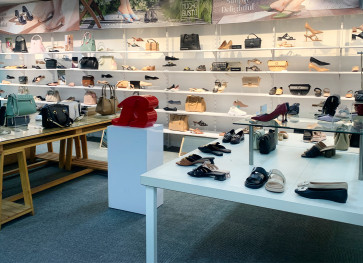Surf’s up
Hanging ten?: Extreme angles lead to a water landing in the surf

H
span class="inline inline-left">Hanging ten?: Extreme angles lead to a water landing in the surf.Despite being born in a village near one of Bali’s top surf breaks, Gus De didn’t take to the waves until he was 25 years old.
A decade on and the beach shack warung owner not only surfs most days, but has also taught his two daughters to boogie board.
Gus says that like many Indonesians growing up by the sea, he learned early of its dangers, and it was not until foreign surfers began showing up on the shores of his home that he saw the ocean as a
potential playground.
Out on Bali’s surf breaks, Gus says it is still 90 percent foreigners that are riding the waves the island has to offer.
“I think a lot of locals are scared of drowning in the sea. Parents teach their kids to be careful of the sea, they worry about their kids, but it would be good to see more local kids surfing. My two daughters are 10 and 12 years old and they both like riding boogie boards and we watch surf movies every day, which they really enjoy,” says Gus, adding that the cost of a new surfboard is also a major stumbling bock for local surfers. Like Gus, most get their chance to surf on boards borrowed or donated from foreigners.
“I have a 5’11” board that suits my body and it’s a fast board, which is great for the waves here at Keramas. A foreign guy gave me the board. It was in two pieces so he said I could have it and so I repaired the board and it’s fantastic. I don’t need a new board. If I have a son, maybe I would buy him a new board, because he would be growing and he would need a board that was right for him. But I am already old and I surf just for fun, so an old board is fine for me,” says Gus adding that because he started so late in life, he could never have become a champion surfer.
“I started at 25 years old and I am not like a cat, my reflexes are not good, so I surf for fun,” says Gus.
Highly regarded surfboard shaper Luke Studer agrees with Gus that the opportunity for Indonesian kids to surf is limited due to equipment costs.
“There are heaps of Indonesian surfers, more now than ever before. Up in the Mentawais, kids are riding broken boards or boards given to them. The kids are living on the beach, but they can’t afford a board. That is probably the biggest difficulty — the equipment. Indonesia has some of the best waves in the world and there are heaps of sponsors. We sponsor a few of the little kids, we give them boards at cost or we give boards to the top up and coming grommets to give them an opportunity [in the sport] into the future,” says Luke from his Sunset Road surfboard showroom. This showroom, with hundreds of boards all made by Luke, would be for Indonesian grommets, like a day in Willy Wonka’s chocolate factory.
“These are like a retro board, it’s what they were surfing on in the ‘50s and ‘60s. It’s like having a ‘57 Chevy, modern boards are more like a Ferrari. The longboards are cruisers — you can walk on them — they are fun,” says Luke.
As in the waves, most of Luke’s customers are foreigners with business driven in part by the increased cost of traveling with a surfboard.
“The number of Indonesian surfers is definitely growing, but 90 percent are foreigners living here [in Bali] or traveling. Boards are becoming more expensive to travel with on planes. It used to cost around US$50 to put a board on a plane, now it can be as much as $300, so people choose to buy a board when they arrive, then sell it or take it with them when they leave,” says Luke as he heads off to offer advice to a young German woman who is in Bali to learn to surf and is in need of a board that meets her skill level.
Perhaps some lucky Indonesian grommet will be in line for a secondhand board when the German surfer heads home.
— Photos By J.B. Djwan









